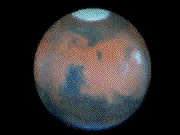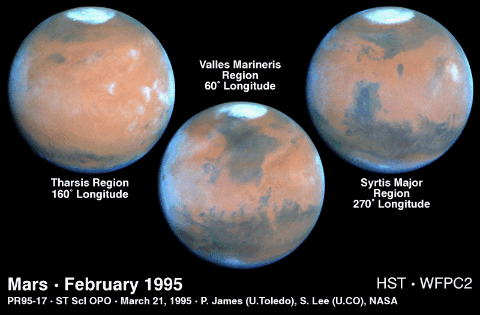General Features
of Mars
 Mars has a rotational period of 24 hours and 37 minutes, a period for
revolution about the sun of 687 days, and a diameter of 6800 km (about half
that of Earth). Its average density is 3.9 g/cc, which is considerably less
than the 5.2-5.5 g/cc characteristic of Mercury, Venus, and the Earth. This
density gives it a mass about 11% of that for Earth.
It is most easily observed from Earth when it is at opposition. Even then, it
was difficult in the past to observe from Earth because of turbulence in the
Martian atmosphere and ours.
Mars has a rotational period of 24 hours and 37 minutes, a period for
revolution about the sun of 687 days, and a diameter of 6800 km (about half
that of Earth). Its average density is 3.9 g/cc, which is considerably less
than the 5.2-5.5 g/cc characteristic of Mercury, Venus, and the Earth. This
density gives it a mass about 11% of that for Earth.
It is most easily observed from Earth when it is at opposition. Even then, it
was difficult in the past to observe from Earth because of turbulence in the
Martian atmosphere and ours.
The animation to the right shows a sequence of Hubble Space Telescope images
of the Martian surface. The image at the bottom of the page shows several
still views from the same source.
Earth based observations concluded that Mars
- Has a reddish hue over 3/5 of the planet, which we now known to be caused by
red dust and rocks on the surface of the planet.
- Has polar ice caps waxing and waning with the seasons that we now know to
be composed both of dry ice (frozen carbon dioxide) and water ice.
- Has surface markings that some originally thought
looked like "canals" from Earth. These are now
known to be features like the edges of mountain ranges.
In 1877 Schiaparelli saw what he thought were canals. People
soon believed these canals were evidence for intelligent life
on mars, where the inhabitants were irrigating water from the poles
to the lower lattitudes. Percy Lowell formed the Lowell observatory
to look at Mars and he mapped what he thought were irrigation
canals and people believed mars was inhabited by intelligent life.
Edgar Burroughs wrote novels about life on Mars between 1912 and 1934. This and the 1895
novel by H.G. Wells "The War of the Worlds"
let to the 1938 Orson Welles famous radio adaptation of the "War of the Worlds."
A relaxing big band dance music show was "interrupted"
to bring a series of "special reports" of a UFO detection and space ship landing in
New Jersey from Mars. Many people believed the show was
a news report rather than a fictional drama. You can hear the broadcast
here .
- Has areas of changing color that were once thought to correspond to
vegetation. We now believe these regions of changing color to be due to
blowing sand, not vegetation.
- Has an atmosphere with clouds.
Increased understanding of Mars had to await the results of space probes,
beginning with Mariner 4, 6, 7, and 9 in the period 1965-1971, and the Viking 1
and 2 probes in 1976.
Most recently we have the
Mars Rovers (latest updates are
here ).
 Mars has a rotational period of 24 hours and 37 minutes, a period for
revolution about the sun of 687 days, and a diameter of 6800 km (about half
that of Earth). Its average density is 3.9 g/cc, which is considerably less
than the 5.2-5.5 g/cc characteristic of Mercury, Venus, and the Earth. This
density gives it a mass about 11% of that for Earth.
It is most easily observed from Earth when it is at opposition. Even then, it
was difficult in the past to observe from Earth because of turbulence in the
Martian atmosphere and ours.
Mars has a rotational period of 24 hours and 37 minutes, a period for
revolution about the sun of 687 days, and a diameter of 6800 km (about half
that of Earth). Its average density is 3.9 g/cc, which is considerably less
than the 5.2-5.5 g/cc characteristic of Mercury, Venus, and the Earth. This
density gives it a mass about 11% of that for Earth.
It is most easily observed from Earth when it is at opposition. Even then, it
was difficult in the past to observe from Earth because of turbulence in the
Martian atmosphere and ours.
